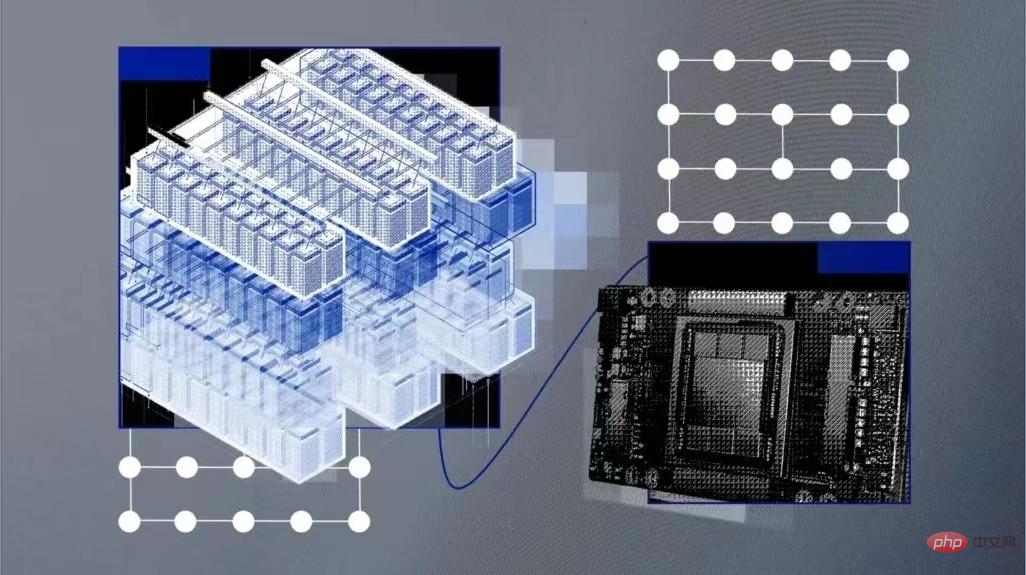 Technology peripherals
Technology peripherals It Industry
It Industry IBM demonstrates nanosheet transistor prototype optimized with liquid nitrogen cooling that more than doubles performance compared to room temperature
IBM demonstrates nanosheet transistor prototype optimized with liquid nitrogen cooling that more than doubles performance compared to room temperatureAt this year’s IEEE International Electronic Devices Meeting (IEDM) in San Francisco in early December, IBM researchers demonstrated the first advanced CMOS transistor optimized for liquid nitrogen cooling

According to our understanding, the boiling point of liquid nitrogen is very low, only -196°C, which is an ultra-low temperature that current mainstream electronic devices cannot withstand. However, in such a cold environment, the transistor's resistance and leakage current are significantly reduced, thus improving performance and reducing power consumption
IBM developed nanosheet transistors by cutting silicon channels into thin Nanosheets and a structure completely surrounded by gates achieve more effective electric field control. This structure can not only compress 50 billion transistors into an area the size of a fingernail, but also double the performance astonishingly under liquid nitrogen cooling
Rewrite: Low-temperature environments offer two main advantages: reduced charge carrier scattering and reduced power consumption. Reduced scattering means reduced resistance, which improves the ability of electrons to move in the device; reduced power consumption allows the device to drive greater current at the same voltage. In addition, liquid nitrogen cooling can also improve the on/off sensitivity of the transistor, requiring only smaller voltage changes to switch states, further reducing power consumption
However, low temperatures also bring new challenges: threshold voltage rise. Threshold voltage is the voltage required to turn a transistor on, and it increases as temperature drops, making it more difficult for the device to switch. It is difficult to reduce the threshold voltage with traditional processes, so IBM researchers used a new dual-metal gate and dual-dipole technology. They added different metal impurities at the interface of n-type and p-type transistors to form dipoles, thereby reducing the energy required for electrons to cross the conduction band edge and making the transistors more efficient
The above is the detailed content of IBM demonstrates nanosheet transistor prototype optimized with liquid nitrogen cooling that more than doubles performance compared to room temperature. For more information, please follow other related articles on the PHP Chinese website!
 拥抱 AI 裁员 8000!百年巨头 IBM 的“广进计划”开始了Mar 18, 2024 am 09:40 AM
拥抱 AI 裁员 8000!百年巨头 IBM 的“广进计划”开始了Mar 18, 2024 am 09:40 AMIBM突然宣布,启动新一轮裁员!在最新一次7分钟员工会议上,IBM首席通讯官宣了这一消息。此次将主要集中在营销和通讯部门。虽然IBM没有就裁员规模发表正式声明,但就在今年1月,他们就已宣布裁员3400人。该公司首席执行官ArvindKrishna早前就表示,公司将在未来五年内,用人工智能取代8000个岗位工作。这一整个突发操作,直接把员工给干懵了……这8000人是不是早就开始裁员了△图源:一亩三分地据相关网站统计,今年迄今为止约有204家科技公司裁员近5万人。包括谷歌母公司Alphabet、亚马
 IBM推出最新工具套件,以便将下一代人工智能开发迁移到大型机平台上Sep 28, 2023 pm 07:37 PM
IBM推出最新工具套件,以便将下一代人工智能开发迁移到大型机平台上Sep 28, 2023 pm 07:37 PMIBM近日宣布,在最近为大型机开发人员推出的生成式AI编码功能的基础上,推出了一套新的产品,使人工智能更容易在他们旧的数据中心硬件上运行IBM表示,IBMZ的更新旨在通过跨多个行业和用例实施业务型AI来帮助客户改善业务成果,其中包括了一组新的开发人员工具包,支持最广泛使用的AI框架和Python编程语言、MachineLearningforz/OS的增强功能、以及IBMz/OS大型机操作系统在性能上的改进。IBM表示,这些更新将让客户能够提高保单建议的准确性,提高反洗钱控制的可靠性和及时效性,降
 ibm是什么意思Feb 08, 2021 pm 03:34 PM
ibm是什么意思Feb 08, 2021 pm 03:34 PMibm的英文全称是“International Business Machines Corporation”,是指国际商业机器公司或万国商业机器公司,总公司在纽约州阿蒙克市。
 IBM 启动 5 亿美元企业人工智能风险基金,以支持初创公司Nov 17, 2023 pm 03:54 PM
IBM 启动 5 亿美元企业人工智能风险基金,以支持初创公司Nov 17, 2023 pm 03:54 PMIBM最近推出了一项新的企业投资工具,即企业人工智能风险基金。该基金的目标是支持那些致力于开发以企业为重点的人工智能产品的初创公司其他科技巨头在IBM此举之前也加大了对人工智能创业生态系统的投资。几周前,大型语言模型开发商AnthropicPBC从亚马逊公司和谷歌公司获得了总额高达60亿美元的融资。最近,惠普企业公司和SAPSE加入了对德国人工智能提供商AlephAlphaGmbH的5亿多美元的投资项目。IBM打算通过企业人工智能风险基金支持一些“从早期阶段到超速增长”的初创企业。据媒体报道,I
 2023 年半导体专利报告:三星遥遥领先,IBM、高通、台积电紧随其后Jan 27, 2024 pm 01:03 PM
2023 年半导体专利报告:三星遥遥领先,IBM、高通、台积电紧随其后Jan 27, 2024 pm 01:03 PM根据知识产权管理公司Anaqua基于公开数据所进行的统计分析,2023年全球半导体专利的数量最多的地区是美国。这已经是连续两年美国占据榜首的情况。该公司利用先进的AcclaimIP专利分析软件,对美国商标和专利局公示的半导体相关专利进行分析。结果显示,2023年的半导体专利数量达到了348,774件,相较于2022年的347,408件略有增长。按照国家和地区划分其中美国公司获得的专利数量为162557件,居各国之首,比2022年增长了18%。数据显示,日本位居第二(40960件),其次是中国(2
 IBM发布“watsonx” AI编程助手,致力于缓解COBOL程序员短缺问题Oct 31, 2023 pm 02:13 PM
IBM发布“watsonx” AI编程助手,致力于缓解COBOL程序员短缺问题Oct 31, 2023 pm 02:13 PMIT之家10月31日消息,IBM公司近日发布新闻稿,为了缓解当前精通COBOL(一种1959年设计开发的编程语言)语言程序员短缺问题,推出了生成式AI编程助手“watsonx”。IBM公司在今年8月推出了名为"IBMZ"的服务,旨在将COBOL转换为Java语言。近日,该服务正式以"watsonx"的名称推出Watsonx的核心功能简化了COBOL代码到Java的转换,旨在实现大型计算机的现代化。IBM表示,该人工智能助手在代码翻译方面准确性极高,能够减少
 IBM开发云原生AI超级计算机Vela 可灵活部署并训练数百亿参数模型Apr 14, 2023 pm 01:46 PM
IBM开发云原生AI超级计算机Vela 可灵活部署并训练数百亿参数模型Apr 14, 2023 pm 01:46 PMChatGPT红遍网络,其背后的AI模型训练也广受关注。IBM研究部门日前宣布,其开发的云原生超级计算机Vela可以快速部署并用于训练基础AI模型。自2022年5月以来,该公司数十名研究人员一直在使用这款超级计算机训练具有数百亿参数的AI模型。 基础模型是基于大量未标记数据训练的AI模型,它们的通用性意味着只需微调就可以用于一系列不同的任务。它们的规模非常庞大,需要大量且成本高昂的计算能力。因此正如专家表示,计算能力将成为开发下一代大规模基础模型的最大瓶颈,训练它们需要花费大量算力和时间。训练可
 利用IBM WatsonX为企业和混合云构建更好的人工智能May 25, 2023 pm 03:46 PM
利用IBM WatsonX为企业和混合云构建更好的人工智能May 25, 2023 pm 03:46 PMIBM在年度IBMThink大会上将AI和混合云战略放到了核心位置。在过去几年里,其他厂商一直专注于新AI应用面向消费者的方面,IBM则一直在开发新一代模型以更好地服务于企业客户。IBM前不久宣布推出了用于混合云应用的AI开发平台watsonx.ai。IBMwatsonxAI开发服务目前处于技术预览阶段,将于2023年第三季度全面上市。AI将成为关键的商业工具,开启生产力、创造力和价值创造的新时代。对于企业而言,这不仅仅是通过云访问大型语言模型(LLM)的新型AI结构。大型语言模型构成了Chat


Hot AI Tools

Undresser.AI Undress
AI-powered app for creating realistic nude photos

AI Clothes Remover
Online AI tool for removing clothes from photos.

Undress AI Tool
Undress images for free

Clothoff.io
AI clothes remover

AI Hentai Generator
Generate AI Hentai for free.

Hot Article

Hot Tools

Zend Studio 13.0.1
Powerful PHP integrated development environment

Notepad++7.3.1
Easy-to-use and free code editor

Atom editor mac version download
The most popular open source editor

SAP NetWeaver Server Adapter for Eclipse
Integrate Eclipse with SAP NetWeaver application server.

MinGW - Minimalist GNU for Windows
This project is in the process of being migrated to osdn.net/projects/mingw, you can continue to follow us there. MinGW: A native Windows port of the GNU Compiler Collection (GCC), freely distributable import libraries and header files for building native Windows applications; includes extensions to the MSVC runtime to support C99 functionality. All MinGW software can run on 64-bit Windows platforms.





